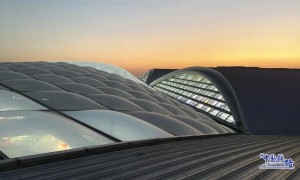《DURABILITY DESIGN OF STEEL FRAMING IN RESIDENTIAL AND LOW-RISE CONSTRUCTION》
《住宅及低层建筑钢结构的耐久性设计》
作者:
Kenneth Watson, National Association of Steel-framed Housing Inc, Australia. Email: kwatson@nash.asn.au
肯尼斯·沃森,澳大利亚国家钢结构房屋协会。电子邮件:kwatson@nash.asn.au
Michael Kelly, National Association of Steel-framed Housing Inc, Australia. Email: mkelly@nash.asn.au
迈克尔·凯利,澳大利亚全国钢结构房屋协会。电子邮件:mkelly@nash.asn.au
George Thomson, Corrosion Control Practice and Standards, Melbourne Australia. Email: corcops@tpg.com.au
乔治·汤姆森,《腐蚀控制实践与标准》,澳大利亚墨尔本。电子邮件:corcops@tpg.com.au
ABSTRACT:
摘要:
Durability is essential to the satisfactory performance of materials and the efficient function of buildings, yet durability design is left largely to the discretion of the designer.
耐久性对于材料的良好性能和建筑的高效功能至关重要,而耐久性设计在很大程度上取决于设计者的判断力。
Steel framing has been shown to give a long life in residential and low-rise structures provided good design and installation practices are followed. Designers and specifiers are faced with numerous Codes, Standards and Handbooks specifying requirements and giving advice on the durability design of these structures. These documents often use different terminology for similar items and sometimes have inconsistent requirements. Generally they concentrate on exposed steel members and give little guidance on internal steelwork. Framing components in residential and low-rise buildings normally have an implicit design life of 50 years. However most current standards and handbooks limit their recommendations to 25 years and this life may require inspection and maintenance which may be impractical for enclosed or concealed components.
如果遵循良好的设计和安装实践,钢结构已被证明在住宅和低层结构中具有较长的使用寿命。设计人员和指定人员面临着大量的规范、标准和手册,这些规范、标准和手册详细说明了这些结构的耐久性设计要求和建议。这些文档经常对类似的项目使用不同的术语,有时需求也不一致。一般集中在裸露的钢构件上,对钢结构内部的指导较少。住宅和低层建筑的框架构件的设计寿命一般为50年。然而,大多数现行的标准和手册将其建议的使用寿命限制在25年,这种使用寿命可能需要检查和维护,这对于封闭或隐蔽的部件可能是不切实际的。
Current regulatory requirements and industry recommendations are reviewed and a durability framework for residential and low-rise steel framing is presented. The framework is based on ISO atmospheric exposure classifications as adapted by AS 4312 for application in the microclimatic variations throughout Australia. In addition to giving recommendations for metallic coated steel members, tables are included for painted systems and connectors which have been shown to give satisfactory performance.
审查了当前的法规要求和行业建议,并提出了住宅和低层钢结构的耐久性框架。该框架是基于ISO大气暴露分类,适用于澳大利亚各地的微气候变化。除了对金属涂层钢构件提出建议外,还包括已被证明具有令人满意的性能的涂漆系统和连接器的表。
The proposed framework will assist designers to identify critical applications and to develop practical and economical solutions for the delivery of long life, low maintenance residential and low-rise building structures.
该框架将帮助设计师识别关键的应用,并为长寿命、低维护的住宅和低层建筑结构开发实用和经济的解决方案。
KEYWORDS:
Durability, design, steel, structural, housing, standards, regulations, residential, framing, buildings
关键词:
耐久性,设计,钢材,结构,房屋,标准,法规,住宅,框架,建筑
1 INTRODUCTION
1介绍
Metallic coated steels and appropriately protected hot- and cold-rolled steels are in general highly durable, long life materials. Using established manufacturing methods and appropriate connection systems, steel framing made from these steels can be adapted to meet to a wide variety of building design challenges. In most service environments in Australian buildings, steel products with appropriate protection will perform their structural function almost indefinitely.
金属涂层钢和适当保护的热轧和冷轧钢通常是非常耐用、寿命长的材料。使用已建立的制造方法和适当的连接系统,这些钢制成的钢框架可以适应各种建筑设计的挑战。在澳大利亚建筑物的大多数使用环境中,经过适当保护的钢产品几乎可以无限期地发挥其结构功能。
There is a wide range of steel products used in building construction, sourced from local and international suppliers through both trade and retail channels. Product usage ranges from protected internal applications to fully exposed external applications, from small residential buildings to large commercial and industrial projects.
建筑用钢材种类繁多,通过贸易和零售渠道从本地和国际供应商采购。产品使用范围从受保护的内部应用程序到完全暴露的外部应用程序,从小型住宅建筑到大型商业和工业项目。
There is an opportunity to improve the available guidance on durability design so that it spans a wider range of environments, applications and products used in residential and low-rise steel framing. The framework presented in this paper is intended to provide that guidance. The solutions presented in Section 6 were developed for the NASH Standard for Residential and Low-rise Steel Framing, Part 2 [1] which was released for public comment on 16th December 2013.
我们有机会改进现有的耐久性设计指南,使其适用于更广泛的环境、应用和产品,用于住宅和低层钢结构。本文中介绍的框架旨在提供这种指导。第6节中提出的解决方案是为住宅和低层钢框架的NASH标准制定的,第2部分[1]于2013年12月16日发布,供公众评论。
2 DEFINITIONS
2定义
The terms durability, design life, expected life and service life have the following definitions when used in this paper:
耐久性、设计寿命、预期寿命和使用寿命在本文中定义如下:
Durability: The capability of a building or its parts to perform a function over a specified period of time. [2]
耐久性:建筑物或其部件在一定时间内完成某种功能的能力。[2]
Design life: The period for which a building, building element or sub-system should fulfil its intended function.
设计寿命:建筑物、建筑构件或子系统应完成其预定功能的期限。
Expected life: The anticipated period of time for which a building, building element or sub-system will fulfil its intended function.
预期寿命:建筑物、建筑物构件或子系统完成其预定功能的预期寿命。
Service life: The actual period of time over which a building, building element or sub-system fulfils its intended function.
使用寿命:建筑物、建筑物构件或子系统实现其预定功能的实际时间。
The ISO definition of durability is more expansive than used here: The capability of a structure or any component to satisfy with planned maintenance the design performance requirements over a specified period of time under the influence of environmental actions or as a result of a self-aging process. [3].
ISO对耐久性的定义比这里使用的范围更广:结构或任何组件在特定时间内,在环境作用或自老化过程的影响下,满足计划维护和设计性能要求的能力。[3]。
3 REGULATORY FRAMEWORK
3监管框架
3.1 NATIONAL CONSTRUCTION CODE
3.1国家建筑规范
As noted by MacKenzie et al [4] the durability performance of Australian building structures and their maintenance to achieve a specific design life is not explicitly regulated by the National Construction Code (NCC) [5] or state legislation. There are some limited exceptions which will be noted later. Durability is currently seen as a building quality matter falling within consumer protection, trade practices or contract law, and Australian regulators show no current inclination to regulate durability design or maintenance practice. However, numerous design and material standards referenced in the NCC contain either normative requirements or informative guidance on durability. Furthermore, durability failure may have human safety implications for the structure, which is a primary concern of the NCC. The Australian Building Codes Board (ABCB) has published a non-mandatory Guideline on Durability in Buildings [2] and encourages industries to develop durability solutions relevant to specific construction materials using the generic principles in the Guideline.
正如MacKenzie等人指出的,澳大利亚建筑结构的耐久性性能及其维护以达到特定的设计寿命并没有被国家建筑规范(NCC)[5]或州立法明确规定。有一些有限的例外情况,稍后将说明。耐久性目前被视为消费者保护、贸易惯例或合同法范围内的建筑质量问题,澳大利亚监管机构目前没有表现出监管耐久性设计或维护实践的倾向。然而,NCC中引用的许多设计和材料标准要么包含规范要求,要么包含关于耐久性的信息指导。此外,耐久性失效可能对结构的人身安全产生影响,这是NCC主要关注的问题。澳大利亚建筑法规委员会(ABCB)发布了关于建筑[2]耐久性的非强制性指南,并鼓励行业使用指南中的通用原则开发与特定建筑材料相关的耐久性解决方案。
By contrast, in New Zealand the durability of building components has been explicitly regulated since 1992 via the New Zealand Building Code (NZBC) [6]. Much of the work in developing the NZBC provisions and associated solutions for specific materials has informed the Australian discussion of durability in residential structures.
相比之下,在新西兰,自1992年以来,建筑构件的耐久性已经通过新西兰建筑规范(NZBC)[6]得到了明确的规定。在制定NZBC条款和特定材料的相关解决方案方面所做的大量工作为澳大利亚关于住宅结构耐久性的讨论提供了依据。
3.2 STEEL STANDARDS
3.2钢结构标准
Steel specifications and design requirements are covered in as many as 20 separate design, material and protection standards, most of which have evolved from the dominant applications in which the individual products are used. There are three design standards that cover the majority of steel structure design in residential and low-rise buildings: NASH Standard Part 1 [7], AS/NZS 4600 [8] and AS 4100 [9]. All three of these design standards contain durability provisions and/or guidance by reference to protection standards [10] [11]. In New Zealand, NZS 3404.1 [12] covers structural steel design and includes corrosion categories and durability provisions. However, most protection standards limit their guidance to 25 years even though many members and components are inaccessible for inspection and maintenance. There is no durability guidance available that covers all elements of a typical steel-framed house or low-rise structure designed for a 50 year life without maintenance.
多达20个独立的设计、材料和保护标准涵盖了钢的规格和设计要求,其中大多数是从单个产品的主要应用中演变而来的。住宅及低层建筑钢结构设计主要有三个设计标准:NASH标准第一部分[7]、AS/NZS 4600[8]和AS 4100[9]。所有这三个设计标准都包含耐久性规定和/或参考保护标准[10][11]的指导。在新西兰,NZS 3404.1[12]包括钢结构设计,包括腐蚀类别和耐久性条款。然而,大多数保护标准将其指导期限限制为25年,即使许多构件和部件无法进行检查和维护。现有的耐久性指南中没有涵盖典型钢结构房屋或低层结构的所有元素,这些结构设计使用寿命为50年,无需维护。
A consistent framework for durability design based on limit states principles and with consistent product designations and definitions would improve the current position and contribute to better and more reliable durability design.
基于极限状态原则和一致的产品设计和定义的耐久性设计的一致框架将改善目前的状况,并有助于更好和更可靠的耐久性设计。
The ABCB Guideline on Durability in Buildings [2] notes that:
ABCB关于建筑耐久性的指南[2]指出:
“In designing for durability, the following factors should be considered –
“在设计耐久性时,应考虑以下因素-
a) intended use of the structure结构的预定用途;
b) required performance criteria要求的性能标准;
c) expected environmental conditions预期的环境条件;
d) composition, properties and performance of the materials材料的组成、性能和性能;
e) structural system结构体系;
f) shape of the members and the structural detailing构件形状和结构细节;
g) quality of the workmanship and level of control工艺质量和控制水平;
h) particular protective measures特殊保护措施;
i) maintenance during the design life设计寿命期间的维护.”
Whilst all these factors are important, in practice it is items (c). (h) and (i) that will have the most significant impact.
虽然所有这些因素都很重要,但在实践中,(c). (h)和(i)项将产生最重大的影响。
4 DESIGN ACTIONS
4设计行为
4.1 NATURAL FORCES AS AN ACTION
4.1自然力作为一种作用力
The AS/NZS 1170 [13] series of standards describes the types and magnitudes of actions due to natural forces that designers must consider. Environmental degradation actions are currently not included. These actions may arise from four main sources:
AS/NZS 1170[13]系列标准描述了设计者必须考虑的自然力作用的类型和强度。目前不包括环境退化行动。这些行动可能来自四个主要来源:
Atmospheric deposition of salt and industrial pollutants大气中盐和工业污染物的沉积;
Biological hazards including termites, borers and various fungal organisms生物危害,包括白蚁、蛀虫和各种真菌生物;
Soil chemistry including pH extremes, salinity, other salts and Potential Acid Sulphate Soils, and土壤化学,包括pH值、盐度、其他盐类和潜在的酸性硫酸盐土壤,以及
Flood- or stormwater-borne contaminants洪水或暴雨携带的污染物
This paper is concerned mainly with atmospheric action on above-ground steel structural components, and soil composition where it affects subfloor conditions. The magnitude of such action varies with geography, climate and distance from salt water or pollutant sources. These agents may arrive as particles or may dissolve in surface moisture and remain after evaporation, to be reactivated when the electrolyte returns with accumulative potency of the substrate solution.
本文主要研究了大气对地面钢结构构件的作用,以及大气对地基条件的影响。这种行动的规模因地理、气候和离咸水或污染源的距离而异。这些试剂可能以颗粒的形式到达,也可能溶解在表面的水分中,蒸发后保留下来,待电解液带着基质溶液的累积效能返回时重新激活。
4.2 ATMOSPHERIC CORROSIVITY CLASSIFICATION
4.2大气腐蚀性分级
AS 4312 [14] describes Australian atmospheric corrosivity zones based on the definitions of ISO 9223 [15]. The ISO 9223 classification system is based on the first year corrosion rates for mild steel as shown in Table 1.
正如4312[14]所描述的澳大利亚大气腐蚀性区域基于ISO 9223[15]的定义。ISO 9223分类体系是根据表1所示的低碳钢第一年的腐蚀速率来制定的。
Table 1: ISO 9223 Atmospheric Corrosivity Categories
表1:ISO 9223大气腐蚀性等级
|
ISO 9223 Category Mild Steel Corrosion Rate |
μm/yr |
| C1 | <1.3 |
| C2 | 1.3 – 25 |
| C3 | 25 – 50 |
| C4 | 50 – 80 |
| C5 | 80 – 200 |
| CX | > 200 |
Once any classification system is formulated, it needs to be geographically calibrated. AS 4312 identifies the proximities, directions and topographies that locate corrosion category boundaries in Australia. It is extensively referenced with corrosion studies by the CSIRO and others covering a period of approximately 50 years. The resulting maps depict zone boundaries for major coastal regions, and a table lists estimated corrosion rates and associated references for major localities. The data and their presentation format are similar to that used for wind speeds, rainfall and other climatic data required in building design.
任何分类系统一旦形成,就需要进行地理校准。AS4312确定了澳大利亚腐蚀类型边界的邻近性、方向和地形。它是广泛参考腐蚀研究由CSIRO和其他覆盖约50年的时期。得到的地图描绘了主要沿海地区的区域边界,并列出了主要地区的估计腐蚀速率和相关参考资料。这些数据和它们的表示形式与风速、降雨和其他建筑设计所需的气候数据类似。
For New Zealand, a similar classification system is presented in NZS 3404.1.
对于新西兰,类似的分类系统在NZS 3404.1中提出。
4.3 MICROCLIMATES
4.3小气候
Identifying the macro-climate of the locality is the first of two steps, and its boundaries are not precise. Of at least equal importance is the micro-climate, which takes into account local features as well as the geometry and orientation of a structure. Micro-climates do not alter the presence or concentration of corrosive agents in the air, but they significantly alter the way these agents accumulate on, interact with and are removed from surfaces.
确定当地的宏观气候是两步中的第一步,它的边界并不精确。至少同等重要的是微气候,它考虑了当地的特点以及结构的几何形状和方向。微气候不会改变空气中腐蚀性物质的存在或浓度,但会显著改变这些物质在表面的积累、相互作用和被清除的方式。
For building structure components, the key microclimate factors are:
对于建筑结构构件,关键微气候因子为:
the extent of physical enclosure, which affects access to surfaces物理外壳的范围,影响接触表面;
the likely wetness cycle, including condensation and可能的湿度循环包括凝结和
the opportunity for surface cleaning, by rainfall or maintenance有机会通过降雨或维护进行表面清洁.
4.4 DESIGN LIFE
4.4设计寿命
The final parameter in the design task is the design life, as defined earlier. Although largely a matter for the designer in consultation with the owner, the “normal” design life of a building of any class is 50 years. New Zealand building regulations are explicit in this requirement. In Australia, the ABCB Guideline on Durability in Buildings [2] provides a method for determining an appropriate component design life.
设计任务中的最后一个参数是前面定义的设计生命期。虽然在很大程度上是设计师与业主协商的问题,但任何等级建筑的“正常”设计寿命都是50年。新西兰的建筑法规明确规定了这一要求。在澳大利亚,关于建筑[2]耐久性的ABCB指南提供了一种确定适当组件设计寿命的方法。
As shown in Table 2, the minimum design life of a component is a function of:
如表2所示,构件的最小设计寿命为:
Table 2: Building and Component Design Life
表2:建筑和构件设计寿命
the design life of the building and建筑的设计寿命
the viability of component repair or replacement部件修理或更换的可行性.
Examples of design lives for major components and systems in buildings with normal building design life are shown in Table 3 [16].
具有正常建筑设计寿命的建筑物主要部件和系统的设计寿命如表3[16]所示。
4.5 DESIGN STRATEGIES
4.5设计策略
The ABCB Durability Guideline describes three quite different strategies for achieving a particular service life:
ABCB耐久性指南描述了实现特定使用寿命的三种完全不同的策略:
1. Design for no maintenance (or “overdesign”)无维护设计(或“过度设计”)
2. Design with periodic repair定期修理设计
3. Design with maintenance设计与维护(勘误:此处应为without)
These strategies are illustrated in Figure 2.
这些策略如图2所示(勘误:此处应为Figure 1)。
Figure 1: Durability design strategies图1:耐久性设计策略
Figure 2: Structural components of typical residential and low-rise structure [7]
图2:典型住宅及低层结构[7]的结构组成
These three strategies have particular relevance to the applications and locations within the building of various components. The practicality and cost to maintain or repair a deteriorated component will influence the durability design decision.
这三种策略与各种组件的构建中的应用程序和位置特别相关。维护或修理损坏部件的实用性和成本将影响耐久性设计决策。
5 BUILDINGS AND APPLICATIONS
5建筑物及应用
For residential and low-rise construction, typical component applications depicted in Figure 2 with design lives listed in Table 3.
对于住宅和低层建筑,典型的组件应用如图2所示,设计寿命如表3所示。
Table 3: Component Design Life Examples [16]
表3:组件设计生命周期示例[16]
6 DURABILITY SOLUTIONS
6持久性解决方案
6.1 HISTORICAL EXPERIENCE
6.1历史经验
What aspects of steel construction work well at present, and where is improvement possible?
目前钢结构的哪些方面做得很好,哪里可以改进?
The experience of the steel-framed housing industry is that enclosed and permanently dry steelwork works well everywhere, even when unprotected. External washed areas work well in most environments, while external unwashed components may deteriorate more quickly especially in coastal and heavy industrial locations.
钢结构住宅行业的经验是,即使在不受保护的情况下,封闭且永久干燥的钢结构在任何地方都能很好地工作。外部水洗区域在大多数环境下工作良好,而外部未水洗部件可能更快地恶化,特别是在沿海和重工业地区。
A simple framework, with acceptable solutions for various components, coatings and environments, deployed right across the industry, would assist all practitioners specify and use appropriately durable steel products.
一个简单的框架,具有可接受的解决方案的各种组件,涂料和环境,部署在整个行业,将帮助所有的从业人员指定和使用适当的耐用钢产品。
6.2 EXPECTED LIFE
6.2预期寿命
In an ideal construction world, all buildings and their critical components would be designed so that their expected life efficiently matched their design life. Expected life is the predicted period for which a building element or sub-system will be able to fulfil its intended function. The designer should specify materials, systems and construction details so that the component or system remains fit for use during its design life, with appropriate maintenance. Where the design strategy involves maintenance, the designer should identify any maintenance requirements on which expected life is dependent [see Figure 1]. Designers may assume that where the durability of any component is dependent on the long term performance and maintenance of other components and systems, those systems regardless of their materials will perform and be maintained for the life of the building. [16]
在一个理想的建筑世界里,所有的建筑和它们的关键部件都将被设计成预期寿命与设计寿命有效匹配。预期寿命是指一个建筑单元或子系统能够完成其预期功能的预期寿命。设计人员应指定材料、系统和施工细节,使组件或系统在其设计寿命内保持适宜的使用状态,并进行适当的维护。当设计策略涉及维护时,设计人员应该确定预期寿命所依赖的任何维护需求(参见图1)。设计师可能会认为,如果任何组件的耐久性取决于其他组件和系统的长期性能和维护,那么这些系统无论其材料如何,都将在建筑的整个生命周期中发挥和维护作用。[16
6.3 SELECTION MATRIX
6.3选择矩阵
Having identified the environments and microclimates for which solutions are required, the appropriate design life and the range of system and component applications, a table of solutions was developed covering corrosivity zones C1 to C4. It is recommended that expert opinion be sought for applications in C5 and CX zones.
在确定了需要解决方案的环境和微气候、适当的设计寿命以及系统和组件应用范围之后,制定了一份解决方案表,其中包括C1至C4腐蚀性区域。建议在C5和CX区域申请时征求专家意见。
In developing the selection matrix for residential and low-rise building structures presented in this paper, the range of specific structural applications has been limited to a manageable number. Table 4 divides these applications into 2 groups based on their accessibility for inspection and maintenance, the implication being that for inaccessible components, a minimum 50 year design life is appropriate when used in “normal” buildings. For accessible components, a minimum 15 year design life is more appropriate, recognising greater accessibility and maintainability.
在开发本文提出的住宅和低层建筑结构的选择矩阵时,特定结构应用的范围被限制在一个可管理的数量。表4根据检查和维护的可访问性将这些应用程序分为两组,这意味着对于不可访问的组件,在“正常”建筑物中使用时,至少50年的设计寿命是合适的。对于易访问的组件,至少15年的设计寿命更合适,因为它具有更好的易访问性和可维护性。
Table 4 drives the selection of durability solutions for each part of the structure. The designations A, B, C and D represent requirements of increasing severity, regardless of the type of component or its protective coating being considered. Durability solutions for each designation are presented in separate tables for materials and fasteners.
表4推动了结构各部分耐久性解决方案的选择。A、B、C和D的名称代表了日益严重的要求,无论考虑的组件类型或其保护涂层是什么。每种型号的耐久性解决方案在材料和紧固件的单独表格中列出。
Table 5 presents solutions for metallic coated steel components such as structural members and connecting brackets. Local availability may influence the selection for some products.
表5给出了金属涂层钢构件(如结构件和连接托架)的解决方案。当地的可用性可能会影响某些产品的选择。
Table 6 presents solutions for components with additional protective paint coatings over metallic coatings.
表6给出了在金属涂层上附加防护涂层的组件的解决方案。
Table 7 presents solutions for components with painted coatings over uncoated steel.
表7给出了在未涂层钢表面涂覆涂层的部件的解决方案。
Table 8 presents solutions for screws and bolts.
表8给出了螺钉和螺栓的解决方案。
The specifications in Tables 5 to 8 have been adjusted to reflect practical commercial availability. Specifications in horizontally adjoining boxes in the tables are acceptable for that designation but are not necessarily equivalent. In the draft standard [1], the tables have explanatory text to guide interpretation and use. For example, in C4 zones it is recommended that roofs and walls be protected with an appropriate sarking membrane after erection.
表5至8中的规格已作了调整,以反映实际的商业供应情况。表中水平邻接的方框中的规格对于该名称是可以接受的,但不一定是等价的。在标准草案[1]中,表中有解释性文字来指导解释和使用。例如,在C4区域,建议在屋顶和墙壁安装后用合适的覆盖膜进行保护。
7 SUMMARY AND CONCLUSIONS
7总结与结论
Durability design is an important matter for designers in all classes of building. The community has a general expectation that durability has been considered in building design. There is a lack of simple easy-to-use durability solutions for residential and low-rise buildings.
耐久性设计是各类建筑设计人员的重要课题。社会普遍期望在建筑设计中考虑耐久性。住宅和低层建筑缺乏简单易用的耐久性解决方案。
The use of appropriately durable components throughout the structure, having regard to the principles that are outlined in this paper, can ensure acceptable performance without inefficient overdesign.
考虑到本文中概述的原则,在整个结构中使用适当的持久组件可以确保可接受的性能,而不会出现低效的过度设计。
This paper seeks to provide a simple framework for durability design of steel framing in Australian residential and low-rise buildings for the purpose of:
本文旨在为澳大利亚住宅和低层建筑的钢结构耐久性设计提供一个简单的框架,其目的是:
Assisting designers to specify an appropriate durability solution for the service environment.协助设计人员为服务环境指定适当的持久性解决方案。
Helping to align products with the durability requirements of the proposed standard to enhance fitness for purpose..帮助产品符合拟议标准的耐久性要求,以增强适用性。
Creating a single building durability framework covering all steel materials used in residential and low-rise construction.创建一个单一的建筑耐久性框架,覆盖所有用于住宅和低层建筑的钢材。
REFERENCES
参考文献
[1] NASH Standard for Residential and Low-rise Steel Framing, Part 2 – Design Solutions, Public Review Draft. NASH Inc, Dec. 2013.
[2] Guideline on Durability in Buildings. Australian Building Codes Board, Canberra, 2007.
[3] ISO 13823: Design of Structures for Durability. International Standards Organisation, 2008.
[4] C. MacKenzie, K. Watson, L. Somerville & G. Stark: The Importance of Durability in Building Performance. Australasian Structural Engineering Conference, 2010.
[5] National Construction Code, Volumes 1 and 2. Australian Building Codes Board. Canberra, 2013.
[6] New Zealand Building Code, Compliance Document B2: Durability. Department of Building and Housing, Wellington, 2011.
[7] NASH Standard for Residential and Low-rise Steel Framing, Part 1 – Design Criteria. NASH Inc., 2005.
[8] AS/NZS 4600 Cold-formed Steel Structures. Standards Australia/Standards New Zealand, 2005.
[9] AS 4100 Steel Structures. Standards Australia, 1998.
[10] AS 2309 Durability of galvanized and electrogalvanized zinc coatings for the protection of steel in structural applications – Atmospheric. Standards Australia, 2008.
[11] AS/NZS 2312 Guide to the protection of structural steel against atmospheric corrosion by the use of protective coatings. Standards Australia/Standards New Zealand, 2002.
[12] NZS 3404.1 Steel structures Standard – Materials, fabrication, and construction. Standards New Zealand, 2009.
[13] AS/NZS 1170 series. Structural Design Actions. Standards Australia/Standards New Zealand.
[14] AS 4312 Atmospheric Corrosivity Zones in Australia. Standards Australia, 2008.
[15] ISO 9223 Corrosion of metals and alloys – Corrosivity of atmospheres – Classification, determination and estimation. International Standards Organisation, 2012.
[16] NASH Handbook – Design of Residential and Low-Rise Steel Framing. NASH Inc, 2009.
[17] AS 1397 Continuous hot-dip metallic coated steel sheet and strip – Coatings of zinc and zinc alloyed with aluminium and magnesium. Standards Australia, 2011. [18] AS/NZS 4791 Hot-dip galvanized (zinc) coatings on ferrous open sections, applied by an in-line process. Standards Australia/Standards New Zealand, 2006. [19] AS/NZS 4792 Hot-dip galvanized (zinc) coatings on ferrous hollow sections, applied by a continuous or a specialized process. Standards Australia/Standards New Zealand, 2006. [20] AS 4750 Electrogalvanized (zinc) coatings on ferrous hollow and open sections. Standards Australia, 2003. [21] AS/NZS 4680 Hot-dip galvanized (zinc) coatings on fabricated ferrous articles. Standards Australia/Standards New Zealand, 2006.
[22] AS/NZS 3566.2 Self-drilling screws for the
building and construction industries – Corrosion resistance requirements. Standards Australia/Standards New Zealand, 2002. [23] AS 1897 Electroplated coatings on threaded components (metric coarse series). Standards Australia, 1976. [24] AS 1214 Hot-dip galvanized coatings on threaded fasteners (ISO metric coarse thread series). Standards Australia, 1983.
补充信息:美国住宅建筑商协会关于镀锌轻钢龙骨耐久性的研究
Summary of a ten year report produced by NAHB Research Center, a subsidiary of the National Association of Home Builders (NAHB) in the US and sponsored by International Zinc Association
全美住宅建造商协会(NAHB)
是美国最大的非盈利性、非政府的行业协会,它由住宅建造商以及与住宅建造业直接有关的技术开发和产品生产企业组成。全美住宅建造商协会迄今已有65年历史,在美国和世界其他将近50个国家拥有203,000个会员,通过全美住宅中心和总数超过850个的附属机构及各州和地方协会,为会员提供广泛的服务。
赞助商是国际镀锌业协会
OVERVIEW 综述
Durability of Galvanized Steel Framing in Residential Buildings was a study commissioned by the International Zinc Association (IZA) that measured actual zinc and zinc-alloy coating corrosion rates of steel framing samples in four different home environments in the US and Canada over a ten year period. The NAHB Research Center was the research contractor
说是NAHB承包了这项研究,在美国和加拿大进行了一个10年期TEN YEAR PERIOD关于镀锌和镀锌合金腐蚀的研究
INTRODUCTION 前言
This summary report is based on the corrosion data presented in the NAHB Research Center’s ten year sample retrieval report, January, 2009. The test sites were in Miami, Florida; Leonardtown, Maryland; and Long Beach Island, New Jersey in the US; and Hamilton, Ontario in Canada. At each site, numerous test samples were installed inside and in some cases, outside of the building (e.g.; roof trusses, floor systems, walls, decks). The ten year coating loss measurements from the four sites have shown minor mass losses for all coating types in all sample colonies (e.g., walls, attics, floor joists). While calculating life expectancies based on the very low coating weight losses found in this study is inexact, the measured coating corrosion rates extrapolate to coating life predictions of 300 to over 1000 years in wall, floor, and roof framing. Sample colonies intentionally located in more aggressive exposures, suchas underneath an outdoor deck and in an exposed crawl space located next to aggressive tidal waters, exhibited higher corrosion rates, but still had a coating life greater than 150 years. Steel is not recommended for outdoor use such as under decks. For an area near the coast or other aggressive bodies of water, steel in a vented or exposed crawl space would be specified with a heavier coating to significantly extend its life.
本总结报告基于NAHB研究中心2009年1月发布的十年样品检索报告中的腐蚀数据。测试地点在佛罗里达州的迈阿密;马里兰州Leonardtown;美国新泽西州长滩岛;还有加拿大安大略省的汉密尔顿。在每个工地,都安装了大量的测试样本,有的安装在建筑物内,有的则安装在建筑物外(例如;屋顶桁架,地板系统,墙壁,甲板)。从四个地点进行的十年涂层损失测量显示,所有样品菌落(如墙壁、阁楼、楼板搁栅)的所有涂层类型的质量损失都很小。虽然基于本研究中发现的极低涂层重量损失计算预期寿命是不准确的,但测量到的涂层腐蚀速率可以推断出涂层在墙壁、地板和屋顶框架中的寿命预测在300年到1000年以上。有意将样本置于更强的暴露环境中,如户外甲板下和靠近强潮汐水域的暴露的爬行空间中,显示出更高的腐蚀速率,但涂层的使用寿命仍大于150年。钢不推荐用于户外使用,如甲板下。对于靠近海岸或其他侵蚀水体的区域,在通风或暴露的爬行空间内的钢材应指定较重的涂层,以显著延长其使用寿命。
CONCLUSION 结论
Coating corrosion was minimal from all four sites, for all sample types (studs and plates), all sample coatings (galvanize, Galvalume®, and Galfan®), and all sample colonies (e.g., crawl spaces, walls, attics, joists). Lower corrosion rates were found with samples installed in wall cavities and attics where the environments were more controlled with less exposure to humid conditions. Higher coating corrosion rates were found in locations with exposures to higher levels of humidity and outdoor pollutants, such as with samples installed in the floor above the carport of the New Jersey site or samples located in the crawl space of the Leonardtown site.For enclosed locations (walls, attics, floors) the extrapolated coating life predictions ranged from 300 to over 1000 years. For exterior exposures or semi-exposed locations in an aggressive environment subject to higher humidity and exterior pollutants, thehigher corrosion rates still extrapolated to over 150 years of coating life.The life span of the zinc and zinc-alloy coated steel samples studied in this project was found tobe well beyond the life expectancies of modern buildings. The results of this study agree with the results from a similar study conducted by Corus Research in the United Kingdom.
对于所有样品类型(螺柱和板)、所有样品涂层(镀锌、Galvalume和Galfan)以及所有样品(例如爬行空间、墙壁、阁楼、搁栅),所有四个位置的涂层腐蚀都很小。将样品安装在壁龛和阁楼中,可以发现腐蚀速率较低,因为壁龛和阁楼的环境控制较好,接触的潮湿条件较少。暴露在较高湿度和室外污染物环境中的地点,如新泽西州场地车库上方的地板上安装了样品,或莱昂纳德敦场地的爬行空间中安装了样品,发现涂层腐蚀率较高。对于封闭的位置(墙壁、阁楼、地板),外推的涂层寿命预测范围从300年到1000年以上。对于外部暴露或半暴露的位置,在一个侵略性的环境中受到较高的湿度和外部污染物,较高的腐蚀率仍然推断出超过150年的涂层寿命。本工程研究的锌及锌合金涂层钢试样的使用寿命远远超过现代建筑的使用寿命。本研究的结果与Corus Research在英国进行的一项类似研究的结果一致。
补充资料 :澳大利亚bluescope从商业层面(质保书)关于镀铝锌产品耐久性的资料
以上毕竟是试验或者研究数据,真正到了商业应用层面,在国外一般以warranty的形式,由产品制造商对产品的使用年限进行保障,为了降低风险,所有warranty都有对应的“免责条款”,研究这种免责条款,是正确应用该产品的一个有效手段。
以澳大利亚bluescope zinalum为例,详细介绍一下厂家愿意承担的质保年限和对应的免责条款。
首先登陆https://warranties.bluescopesteel.com.au
假设我们是澳洲某房屋的业主,我们选择如下:
右侧可以选择产品系列,选择truecore产品,就是淡淡的蓝色那种钢带,如G550AZ150,下方有个滑动条,代表距离海边(或者污染源)的距离,选择100米(注意:100米内是无法选择的,也就是100米内bluescope不提供质保),右侧圆形图案有三个选项,分别是:
Surf: Area exposed to breaking surf and ocean spray
Exposed: Open expanses of salt or brackish water exposed to onshore winds, but not typically prone to breaking surf
Calm: Protected areas of salt or brackish water, including ports, harbours, bays, and river estuaries
选择calm这种正常环境,给出的结论是主结构最高50年,局部最高25年……如果感兴趣,自己可以尝试各种组合。
最后,给出一个warranty的范本,最后唠叨一句,任何没有条件的承诺都是耍流氓……
G550AZ150的钢带,全世界最好,最大,知名度最高的生产商bluescope,承担法律责任的质保是:在离海边100米以上,全部包覆非暴露的条件下,按规范施工……等条件下,厂家承担的质保责任是50年。
但是,需要特别说明的是,质保年限不代表实际使用寿命。比如汽车常规质保期是三年或十万公里,但是任何一个人不会认为汽车的使用寿命是三年,对吧?
如果您认为本文有帮助或启发,
请点击下方“喜欢作者”,
您的评论和转发是对我最大的支持!








